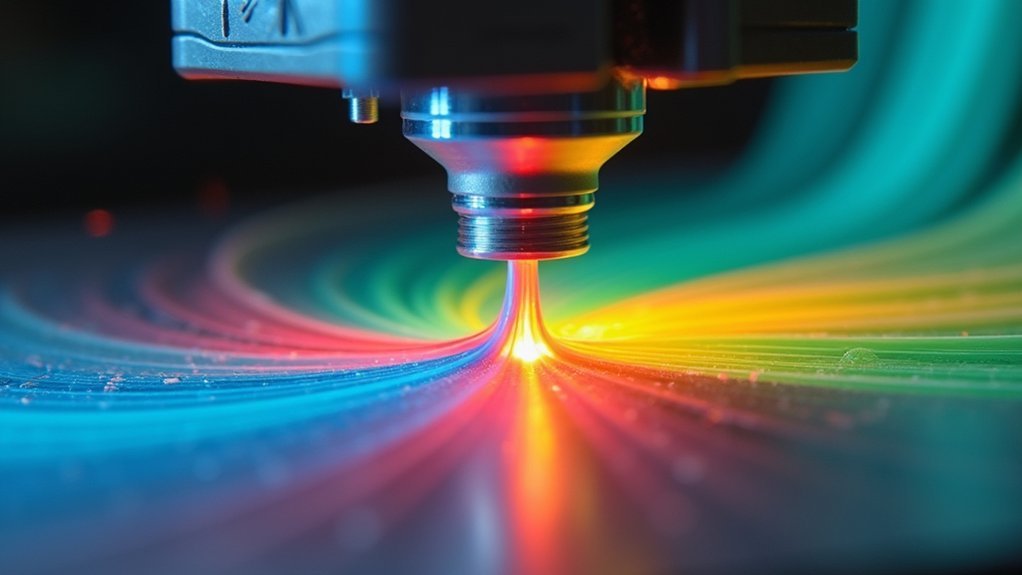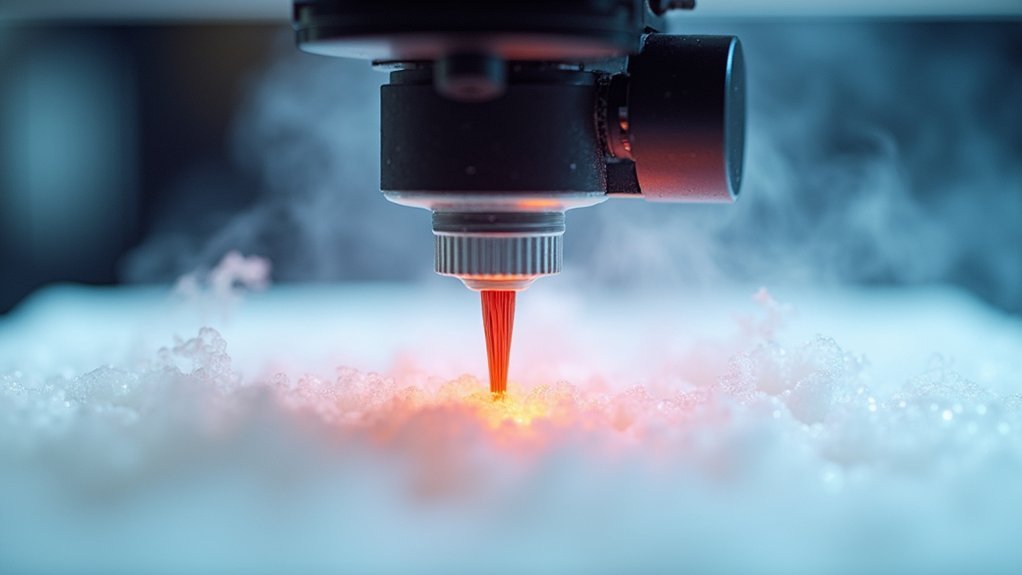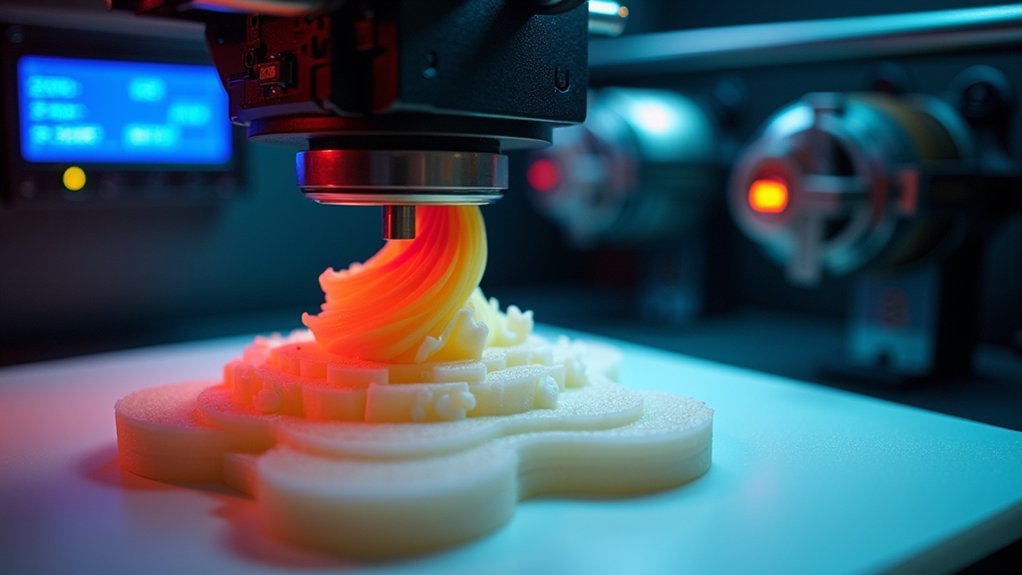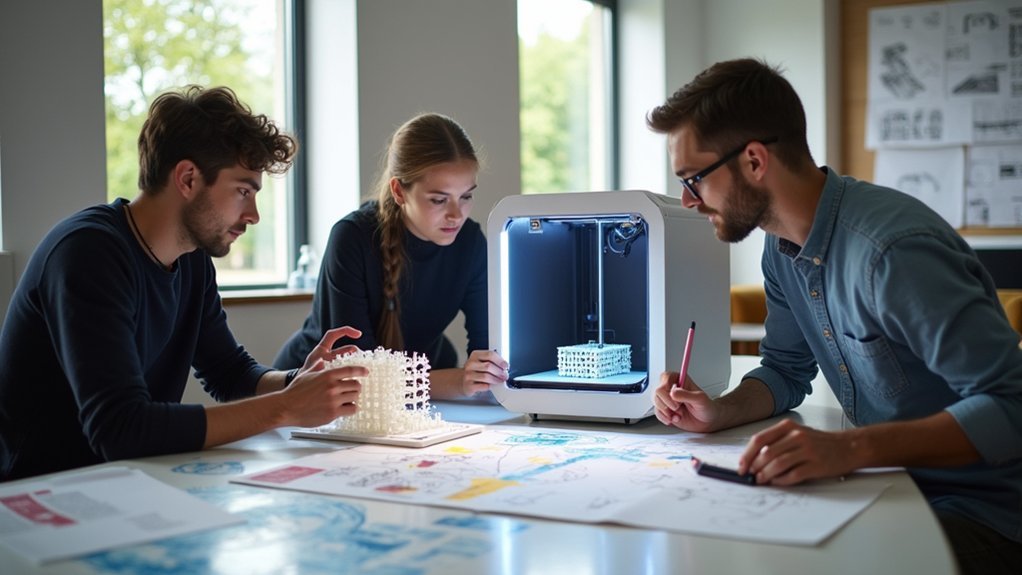Linear advance dramatically improves your print quality by solving pressure lag issues inside your extruder nozzle. When you’re printing, pressure fluctuations occur during rapid movements and direction changes, causing over-extrusion during deceleration and under-extrusion during acceleration. This results in corner bulging and inconsistent wall thickness. Linear advance predicts these pressure changes and dynamically adjusts your filament feed rates, ensuring consistent material deposition and sharper corners. The following guide explains proper calibration techniques for ideal results.
Understanding Pressure Control in Nozzle Extrusion Systems

The nozzle’s internal pressure dynamics directly determine your print’s final quality, making pressure control one of the most critical aspects of successful 3D printing.
When your printer moves rapidly or changes direction, pressure fluctuations occur within the nozzle chamber. Without proper pressure control, you’ll experience over-extrusion during deceleration and under-extrusion during acceleration.
This inconsistent flow creates visible defects like bulges at corners and weak connections between layers.
Linear advance addresses these issues by predicting pressure changes and adjusting filament feed rates accordingly. The system monitors your nozzle’s movement speed and preemptively modifies extrusion to maintain steady internal pressure.
This precise regulation guarantees consistent material flow regardless of print head acceleration, delivering superior print quality with clean edges and uniform surface finish.
How Linear Advance Eliminates Bulging at Corner Transitions
Corner bulging represents one of 3D printing’s most persistent quality issues, occurring when your print head decelerates at directional changes and excess filament creates unsightly bumps.
Linear advance solves this problem by dynamically adjusting your extrusion rate based on acceleration and speed changes. When your printer approaches a corner, linear advance reduces filament pressure before the directional change occurs, preventing material overshoot that causes bulging.
You’ll achieve sharper corners and cleaner shifts because linear advance regulates nozzle pressure precisely during rapid movements.
The Science Behind Consistent Filament Flow During Speed Changes

Understanding how filament behaves during speed variations reveals why linear advance produces such dramatic quality improvements.
When your printer changes speed, pressure inside the nozzle doesn’t instantly match the new flow requirements. This creates a lag that causes over-extrusion when slowing down and under-extrusion when speeding up.
Linear advance solves this by predicting pressure changes and adjusting extrusion preemptively:
Linear advance eliminates print defects by calculating pressure changes before they occur, ensuring perfect extrusion timing during speed transitions.
- Pressure Compensation – Adjusts for nozzle pressure buildup during acceleration
- Flow Prediction – Anticipates required filament output based on print speed changes
- Dynamic Response – Modifies extrusion rate in real-time during directional changes
- K Value Optimization – Fine-tunes response sensitivity for your specific material
This scientific approach guarantees consistent material deposition regardless of speed fluctuations.
Calibrating K-Factor Values for Optimal Material Response
While linear advance theory explains the science, achieving ideal results requires precise K-factor calibration for your specific material and printer setup.
You’ll start with the default value of 0.22, then test a range typically between 0.1 and 0.25. Print calibration patterns to visually assess extrusion consistency, looking for smooth, even lines without bulging at corners or thin spots during direction changes.
Examine each test line carefully—the best K-factor produces uniform width throughout the pattern.
Once you’ve identified the best value, use the M900 command to set it in your firmware. Remember that different filaments require unique calibration; what works for PLA won’t necessarily work for PETG or ABS.
Recalibrate whenever you switch materials to maintain consistent print quality.
Firmware Requirements and Stepper Driver Compatibility

Having the right K-factor won’t help if your firmware can’t execute linear advance commands properly.
Your printer’s foundation must support this advanced feature through specific firmware requirements and compatible hardware.
You’ll need to verify these essential components before implementing linear advance:
- Compatible firmware like Marlin with linear advance enabled in configuration files before compilation
- Functional bootloader to accept firmware updates that include linear advance functionality
- Properly calibrated e-steps ensuring accurate extrusion for consistent linear advance performance
- Compatible stepper driver avoiding certain TMC 2208 modes that don’t support linear advance
Your stepper driver choice greatly impacts linear advance effectiveness.
Some drivers simply can’t handle the rapid acceleration changes linear advance demands, limiting your hardware options for ideal print quality.
Generating and Interpreting Linear Advance Test Patterns
Once your firmware and hardware are properly configured, you’ll need to generate test patterns that reveal your printer’s best K-factor through systematic evaluation.
Linear advance test patterns use alternating slow and fast moves to expose extrusion inconsistencies at direction changes and sharp corners. These calibration patterns feature vertical markers filled with varying K values, letting you visually compare how different settings affect print quality.
Linear advance patterns reveal extrusion flaws through speed variations, enabling precise K-factor optimization through visual comparison of test markers.
Ensure your bed dimensions are accurate when generating patterns to prevent collisions.
During testing, examine each marker for ideal corner sharpness and consistent extrusion. You’ll typically narrow down your selection to a precise range like 0.1 to 0.25.
Once you’ve identified the best-performing K value through visual inspection, use the M900 command to save it in EEPROM for automatic application in future prints.
Fine-Tuning Retraction Distance With Linear Advance Enabled
After enabling linear advance, you’ll need to recalibrate your retraction distance since the feature’s dynamic pressure control changes how filament behaves during retractions.
Linear advance compensates for pressure variations, allowing you to potentially reduce retraction distance while maintaining excellent print quality.
Here’s how to optimize your settings:
- Start by reducing your current retraction distance by 0.5-1mm when first enabling linear advance.
- Print test objects with travel moves to observe stringing and oozing behavior.
- Adjust retraction distance in 0.2mm increments until you achieve clean shifts.
- Test different filament types separately, as each material responds differently to retraction changes.
With properly tuned retraction distance and linear advance working together, you’ll achieve faster print speeds without sacrificing detail or introducing blobbing artifacts.
Slicer Configuration Adjustments for Maximum Effectiveness
To get the most from linear advance, you’ll need to disable conflicting slicer features that can interfere with its precision.
Turn off pressure advance, coasting, and wipe settings in your slicer configuration since these functions duplicate what linear advance already handles more effectively.
You’ll also want to fine-tune your retraction settings to work harmoniously with linear advance rather than against it.
Disable Pressure Advance Features
When implementing linear advance on your 3D printer, you’ll need to disable conflicting pressure advance features within your slicer to prevent interference with filament flow regulation.
These settings create competing adjustments that compromise print quality by disrupting the consistent extrusion control that linear advance provides.
Essential slicer settings to disable include:
- Coasting – Turns off filament flow before path completion
- Extra restart length after retract – Adds unnecessary filament compensation
- Wipe while retract – Creates inconsistent flow patterns during retractions
- Combing – Alters travel paths that affect pressure calculations
Verify these pressure advance features are turned off, especially in Simplify 3D.
This guarantees linear advance operates without interference, delivering sharper corners and eliminating bulges or ghosting effects for superior print quality.
Turn Off Coasting
Since coasting causes your extruder to stop pushing filament before completing each print path, it creates premature flow reduction that directly conflicts with linear advance’s pressure management system.
You’ll notice blobs and inconsistencies at line starts and ends when coasting interferes with proper extrusion control.
Turning off coasting eliminates over-extrusion that creates bulging at corners and direction changes. This preserves sharp feature definition and improves print quality considerably.
When you disable coasting, linear advance can effectively manage filament pressure without interference, resulting in smoother shifts and superior corner accuracy.
Slicers like Simplify 3D offer coasting length adjustments, but disabling it entirely guarantees linear advance operates ideally.
You’ll achieve more consistent extrusion, reduced artifacts, and cleaner prints.
Adjust Retraction Settings
Three critical retraction parameters require adjustment when optimizing linear advance: distance, speed, and restart behavior.
When you’ve enabled pressure advance, your retraction settings need fine-tuning to prevent artifacts and maintain print quality.
Configure these essential parameters:
- Retraction Distance – Set between 0.5-2mm depending on your filament type and nozzle diameter to minimize pressure fluctuations.
- Extra Restart Length – Add 0.1-0.3mm to counteract filament loss during retraction moves.
- Wipe While Retract – Disable this feature to reduce artifacts during travel moves.
- Retraction Speed – Match speed settings to your pressure advance calibration for consistent extrusion.
These adjustments guarantee your retraction settings work harmoniously with linear advance, eliminating blobs, zits, and stringing while maintaining smooth shifts between print paths.
Material-Specific K-Value Optimization Techniques
Although different filament materials share similar printing principles, each requires its own carefully tuned K-value to achieve optimal linear advance performance. The calibration process involves printing test patterns to evaluate extrusion quality and identify suitable settings for each material type.
| Material | Recommended K-Value Range |
|---|---|
| PLA | 0.10 – 0.15 |
| PETG | 0.15 – 0.20 |
| ABS | 0.12 – 0.18 |
| TPU | 0.20 – 0.25 |
| HIPS | 0.10 – 0.16 |
You’ll adjust values based on visual defects like bulging or under-extrusion during test prints. Higher flow materials typically need lower K-values, while viscous filaments require increased compensation. Implement your refined K-value using the M900 command in your G-code to ensure automatic adjustments for different materials.
Measuring Print Quality Improvements Through Visual Assessment
You’ll want to capture before and after photos of your test prints to document the visual improvements linear advance provides.
Compare identical test cubes printed with and without linear advance enabled, focusing on corner sharpness, extrusion consistency, and detail definition.
These side-by-side comparisons will clearly show how different K values impact your print quality, making it easier to identify the ideal settings for each filament type.
Before and After Comparison
When you examine test prints side by side, the difference between using linear advance and standard settings becomes immediately apparent.
Your test cube reveals dramatic improvements in print quality that you can see with the naked eye.
The before and after comparison shows these key improvements:
- Sharper corners – Linear advance eliminates the bulging that typically occurs at direction changes.
- Consistent wall thickness – Your prints maintain uniform extrusion throughout the entire layer.
- Reduced ghosting effects – Particularly noticeable on X and Y axes where filament control becomes more precise.
- Cleaner edges – Surface artifacts and extrusion inconsistencies virtually disappear.
With an ideal K value of 0.11, you’ll achieve visually superior prints that showcase the technology’s impact on overall quality and precision.
K Value Optimization Results
Finding the ideal K value alters your print quality in measurable ways that you can evaluate through systematic visual assessment. When you analyze calibration patterns with different K values, you’ll notice dramatic improvements in corner sharpness and wall consistency. Your optimized K value, like 0.11, eliminates pressure buildup that causes bulging and ghosting effects.
| Assessment Area | Before Optimization | After Optimization |
|---|---|---|
| Corner Sharpness | Rounded, bulged | Clean, precise |
| Wall Consistency | Uneven thickness | Uniform surface |
| Direction Changes | Visible artifacts | Smooth shifts |
| X/Y Axis Ghosting | Pronounced shadows | Minimal ghosting |
| Overall Quality | Inconsistent extrusion | Professional finish |
You’ll see these improvements immediately when comparing test prints, making K value calibration essential for achieving professional-grade results.
Advanced G-Code Commands for Automated Linear Advance Control
While basic linear advance calibration provides a solid foundation, mastering advanced G-code commands reveals automated control that adapts to your specific printing conditions in real-time.
The M900 command becomes your primary tool for setting the K value dynamically, enabling sophisticated pressure control adjustments throughout your prints.
Transform your printing workflow with these advanced G-code techniques:
- Start G-code automation – Insert M900 commands to automatically apply ideal K values for different filament types
- EEPROM storage integration – Save calibrated settings permanently to eliminate recalibration needs
- Layer-specific adjustments – Deploy multiple M900 commands for dynamic control across different print regions
- Slicer coordination – Disable conflicting pressure advance and coasting settings while maintaining G-code control
These automated approaches guarantee consistent quality while reducing manual intervention.
Troubleshooting Common Issues With Linear Advance Implementation
When you’re implementing linear advance, you’ll likely encounter three main categories of problems that can sabotage your print quality improvements.
Your stepper drivers mightn’t play nicely with linear advance, especially if you’re running TMC 2208s in certain modes that can’t handle the rapid acceleration changes.
You’ll also need to watch for incorrect K value calibration and conflicting slicer settings that can counteract linear advance’s benefits.
Stepper Driver Compatibility Issues
One vital factor that can sabotage your linear advance implementation is stepper driver compatibility, particularly with certain TMC drivers that simply don’t play well with this feature.
The TMC 2208 in specific modes can cause inconsistent extrusion and print quality degradation when paired with linear advance. Your stepper motor’s performance directly impacts how well linear advance regulates nozzle pressure, making driver selection essential.
Here’s what you should check:
- Verify firmware settings – Confirm you’ve selected the correct stepper driver configuration.
- Test different drivers – Try TMC 2130 or TMC 2209 for better linear advance compatibility.
- Adjust current settings – Fine-tune motor current if you’re experiencing extrusion problems.
- Update firmware regularly – Stay current with community documentation and troubleshooting guides.
If you’re experiencing print quality issues after enabling linear advance, driver incompatibility might be the culprit.
Incorrect K Value Calibration
Beyond driver compatibility problems, incorrect K value calibration stands as the most frequent cause of linear advance failures. When you don’t calibrate properly, you’ll experience over-extrusion or under-extrusion, creating uneven surfaces and visible artifacts.
| K Value Range | Print Result |
|---|---|
| Too High | Corner bulging |
| Too Low | Gaps, weak adhesion |
| 0.1-0.15 | Light filaments |
| 0.15-0.25 | Heavy filaments |
You’ll need to generate specific G-code patterns to assess different K values visually. Test within the 0.1 to 0.25 range for precise calibration. Once you’ve identified your ideal value, use the M900 command to store it in EEPROM. This guarantees your printer maintains correct settings across different filament types.
Slicer Setting Conflicts
Although linear advance calibration might be perfect, conflicting slicer settings can sabotage your print quality and negate all the benefits you’ve worked to achieve.
Your slicer settings must align with linear advance parameters to prevent artifacts and maintain consistent extrusion.
Disable these conflicting features immediately:
- Pressure advance – Creates competing extrusion control systems
- Coasting and extra restart length – Interferes with precise filament flow
- Wipe while retract (Simplify 3D) – Causes unintended filament movement
- Combing settings – May trigger unwanted travel movements
When these settings conflict with linear advance, you’ll experience bulges, ghosting, and inconsistent walls despite proper calibration.
Regular testing with different filament types guarantees your slicer settings complement linear advance functionality for peak performance.
Frequently Asked Questions
What Is the Most Common Cause of Poor Print Quality?
You’ll find inconsistent extrusion causes most poor print quality issues. This creates under-extrusion, over-extrusion, and surface defects. It’s typically caused by improper e-steps calibration, poor bed leveling, or filament quality problems.
What Does Linear Advance Do?
Linear advance adjusts your extruder’s filament flow based on print head speed changes. It prevents over-extrusion during deceleration and under-extrusion during acceleration, giving you sharper corners and cleaner details.
Does Slowing Down Print Speed Increase Quality?
You’ll generally see improved print quality when you slow down speeds because your printer gains better control over filament flow, reduces artifacts like stringing, and achieves sharper details in corners.
What Is the Difference Between Linear Advance and Pressure Advance?
You’ll find linear advance dynamically adjusts extrusion during real-time printing movements, while pressure advance uses static slicer settings. Linear advance adapts to varying speeds and accelerations, providing better precision than pressure advance’s uniform approach.





Leave a Reply